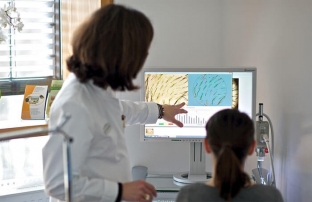Various hormonal disorders – this is one of the most widespread problems of women of different ages. The result of such pathological processes is a violation of menstrual and reproductive functions, as well as deterioration of the skin structures in the form of acne and hair loss. Androgenetic alopecia – This is female pattern baldness, which occurs as a result of excessive production of male sex hormones in the body of a woman. Read about the features of the diagnosis and treatment of androgenetic alopecia in women at estet-portal.com.
Peculiarities of diagnosis and treatment of androgenetic alopecia in women
Androgenetic alopecia is a fairly common cause of hair loss among females.
Often, these patients have other signs of hyperandrogenic syndrome: acne, oily seborrhea, excessive facial hair growth. At the same time, the symptoms of virilization in androgenetic alopecia are extremely rare. Such a condition may be the result of a hormonal imbalance in diseases of the endocrine system, or in case of hormonal failures due, for example, to the illiterate use of hormonal contraceptives. The diagnostic process of androgenetic alopecia in women has some features that are important to clarify in order to select an effective treatment regimen for this disease.
Androgenetic alopecia:
- causes of androgenetic alopecia in women;
- methods for diagnosing androgenetic alopecia in women;
- effective treatment for androgenetic alopecia in women.
Causes of androgenetic alopecia in women
Androgenetic alopecia accounts for about 95% of all male and female pattern baldness. If male androgenetic alopecia is most often manifested by hair loss starting from the front, from the line of their growth to the crown, then in women the disease is characterized by progressive thinning and thinning of hair almost throughout the head. This state can be caused by the following reasons:
- increased levels of the male sex hormone dihydrotestosterone in a woman's body;
- increased sensitivity of a woman's hair follicles to dihydrotestosterone;
- increased activity of 5-alpha reductase – an enzyme that converts testosterone to dihydrotestosterone.
Methods for diagnosing androgenetic alopecia in women
The diagnosis of androgenetic alopecia in women is based on the following features:
- the woman also has other signs of androgenetic alopecia: thinning and progressive hair loss, signs of acne and hirsutism;
- according to the results of microscopic examination, the presence of miniaturized follicles is determined;
- when counting the number of hairs that are in different growth phases, the imbalance between the hair follicles that are in the resting stage and the follicles that are in the growth stage is determined;
- microscopic examination also shows that miniaturization of follicles and diffuse hair thinning are not observed on the lower part of the occiput.

Effective treatment of androgenetic alopecia in women
Treatment of androgenetic alopecia in women includes specific and non-specific therapies. First of all, it is necessary to eliminate the etiological factor of the disease. To this end, on the basis of a study of the hormonal profile of a woman, the necessary scheme of antiandrogen hormone therapy is selected for her. Normalization of the hormonal background reduces hair loss, but does not lead to the restoration of their previous density. That is why women are prescribed hair growth stimulants.
Conservative treatment of androgenetic alopecia – it is a long process, the first results of which appear only after a few months from the start of therapy.
If conservative methods of treatment are ineffective and the disease progresses, the problem of hair loss can be solved by surgical intervention.









Add a comment